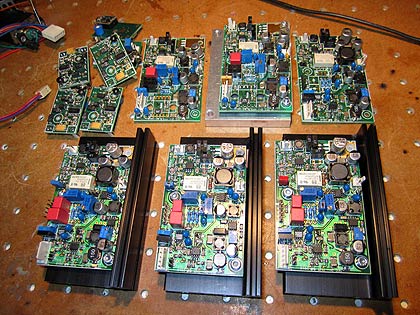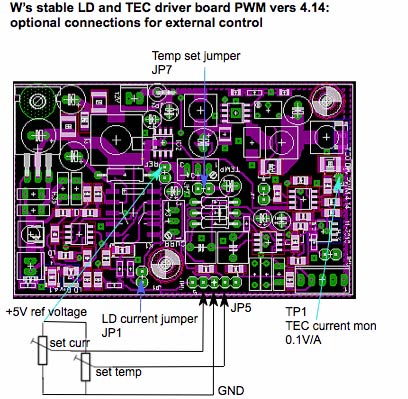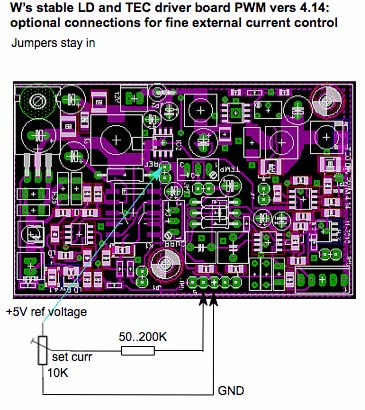
Return to sale page
Return to diode laser page
Return to home page

This board is the next generation after the board based on the HY5600 (of which I ran out). Most remarks made for this apply here as well. The main difference for the end user is that the LD driver is somewhat stronger such as to cope with the blue Nichia diodes.
The circuit is a combination of a highly stable, low noise diode driver and of a TEC controller based on the L5973D PWM stepdown chip. It uses high precision Vishay bulk metal foil resistors and an ultrastable voltage reference for maximal temperature stability. The diode driver is designed to handle up to 375mA without changes, and by changing a few components, it can produce up to 500mA. For external control, the two jumpers that connect the inputs to the trimmers can be removed. There is also an output of the reference voltage, which can be used with external 10K potentiometers for convenient remote adjustment (note that only wirewound pots like the Beckmann 7286 have a good temperature coefficient).

Specifications
Operating voltage: 9-12V for red diodes, 11-12V for blue diodes
typ current 0.3-0.7A, peak < 1.5A, fast 2A fuse advised
50Hz ripple should be less than approx 20mV; a LM317 or 7809 style preregulator should be doing fine.
High frequency ripple from eg., a switchmode supply, is filtered out.
Size without heat sink: 50x80mm
Heat sink 94x55mm or 99x55mm with M3 screw channels for easy mounting
Weight: 200g
Laser diode current: 375mA max, changeable to 500mA max.
Laser diode noise: <1uA (below measurement limit)
Current monitor: 1V/100mA
Control voltage when in external mode: 75mA/V (0 - 5V), changeable to 100mA/V.
Soft start: ca 10ms
Various diode protection features
Thermistor type: NTC with 10K @ 25C
TEC current: 2A max
TEC voltage: 10V max
recommended TEC size: for single diode: 1703 style, 15x15mm, for ECDL: 40x40mm
PWM ripple: <10mV
Warmup time: approx 10min, but for best stability wait for 1h
Temperature drift at constant ambient temp: as good as or better than 1mK over several hours (with optimal mechanical design)
Short term temperature fluctuations: better than 0.2mK (with optimal mechanical design)
Temperature stability from ambient temp: approx 0.25-0.8mK/C (for slow changes; with optimal mechanical design)
Temperature control voltage when in external mode: 0 - 5V gives approx 15.3 - 18.5C
Temperature monitor voltage: 2.5-2.75V corresponds to approx 15.3 - 18.5C

Further details and measurement data can be found at the respective pages for the diode driver and the TEC controller.
Operation notes:
1) The TEC current limit pot can to be adjusted such that the current through the TEC is reduced; it should be maximally set to 1.6A. This corresponds to 0.16V at test point TP1; see below. It should normally not be changed from the nominal setting. If there is long cable to the TEC one might slightly increase the voltage so that the maximum current of approx 1.6A can flow.
2) External control is possible by removing one or both jumpers (JP1,JP7) that connect to the diode current/temperature trimmers, and making use of the pin header "REF". One may connect external pots by connecting their wipers to JP5 and their end points to the ground and ref voltage pins. The pots should have 5-20K or so.
Note that this may compromise temperature stability, unless multi-turn wirewound pots (like eg a Beckman 7280 helipot) are used; they have a very good tempco, actually better than the trimmer pots. Note also: putting external pots may endanger the laser diode, if its rating can be exceeded by the max current (no danger for the 1W Nichias, though). In particular, wrong wiring may have the diode run at full current; it is strongly advised to test before with a dummy load!
I would recommend to only use an external pot for the current and set the temperature once for all internally.


Each board has been tested and burned in for at least 24h. Nominal presets are 100mA diode current, 3V TEC control voltage (yields appr 17C), and 2V max TEC drive voltage. I can supply also a suitable peltier element that fits to the board, plus thermister, for self-cost.
Vers 1.5 12/2010